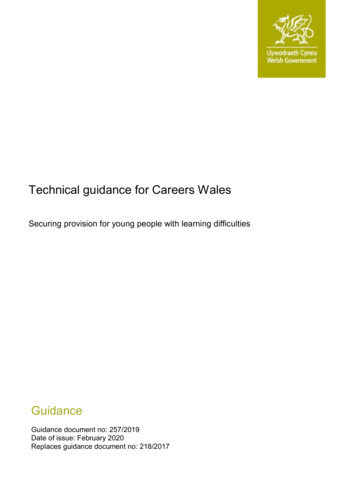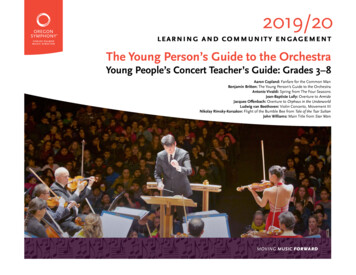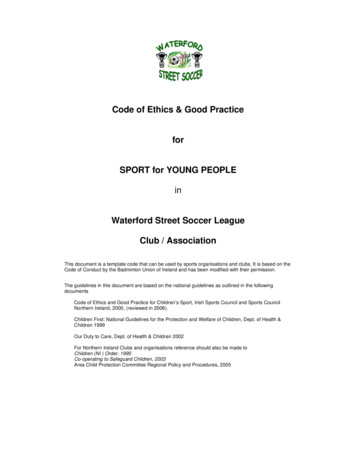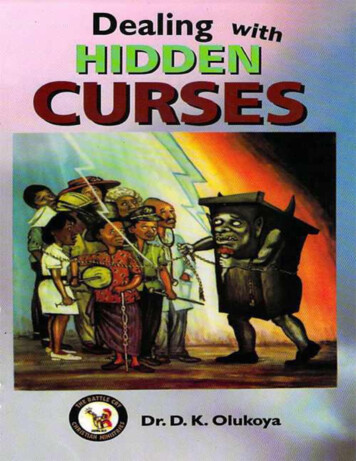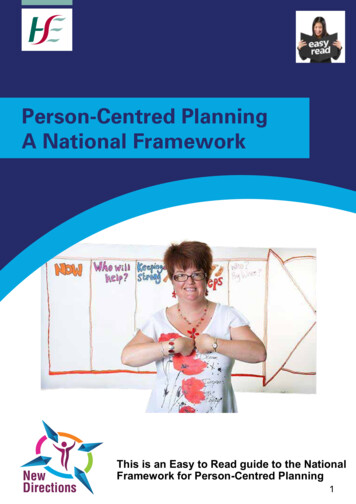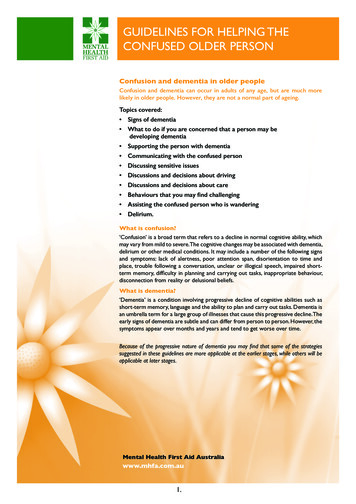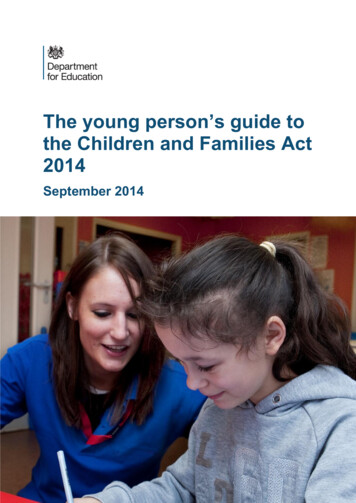
Transcription
The young person’s guide tothe Children and Families Act2014September 2014
ForewordMy name is Edward Timpson. I am the Children’s Minister and a Conservative MP inParliament. This is the first Act of Parliament I have been responsible for and I am really proudof it. Before I was elected to Parliament, I was a barrister working to help children in the familycourts and, when I was growing up, I lived in a family with lots of foster brothers and sistersMy name is Jo Swinson and I am the Minister for Employment Relations and Equalities and aLiberal Democrat MP in Parliament. I worked with Edward Timpson on the Children’s andFamilies Act. I am also very excited about the ways the Act helps families and children.This Guide tells you what is in the Children and Families Act 2014, a new law that is veryimportant for children. We think children should know about new laws that will make a differenceto their lives. We want you to know the new laws the Government has passed for you. ThisGuide is a good summary of what you need to know in the new Act. If you need to checksomething out in more detail, you will need to look at the exact words in the Act itself.We want all children and young people to do well and we want to support families. We thinkservices should do what children need. Children should get the help they need without lots ofdelays. We want to improve children’s rights in this country. Some changes in the Act affect allchildren and families. Some affect groups of children like children in care; children with adisability or special educational needs at school or college, young carers, or children beingadopted.The Act makes changes to help children get adopted faster if adoption is the right thing forthem. It will help children who are in the care of the council to do better at school. It will makechanges to help the family courts work better for children. It will make changes to help childrenand young people who have a disability or special educational needs at school. It will alsochange the way the Children’s Commissioner works for children.The Act makes changes to help with many sorts of difficulties or challenges children can face intheir lives. It will make sure schools give more help to children who have medical problems. Itwill mean more help for young carers who look after someone else. For children in care, thereare changes to improve children’s homes. There are changes that will let foster children carryon staying with the families who have fostered them after they reach 18. All children will be ableto have free school lunches in their first few years at school. And it will make changes to protectchildren from getting addicted to tobacco or harmed by smoking.The new law will help families by giving mums and dads more choices about sharing time offwork after a baby is born. It will give parents who work more choice about the times they go towork. It will help families to get good care for very young children.Overall, it is about making children’s lives better.Edward Timpson MPMinister for Children and FamiliesEqualitiesJo Swinson MPMinister for Employment Relations and
ContentsForeword2Introduction4What the Act does6What the new Act says about adoption7What the Act says about family courts7How the Act helps children and young people with special educational needs or adisability7What the Act says about helping parents by caring for children outside school7Other new laws to make things better for children7How the Act changes the Children’s Commissioner7How the Act helps parents when they have a new child7How the Act helps people fit their work times around other things in their lives7
IntroductionWhat is an Act?This Guide is about a new Act called the Children and Families Act 2014. Somethings in it are completely new. Other things in it change what used to be in the law.It does not say everything that is in the law about children and families, but only whatis new and what is changed. And it doesn’t cover everything that is changing thesedays to do with children and families. Lots of changes happen without having to beput in the law. Making things better is a mixture of doing things better and changingthe law where it needs to be changed. This Act changes the law where theGovernment thinks and Parliament agrees it needs changing to make things betterfor children and families.An Act of Parliament is a part of the law of this country. There are lots of Acts. Eachof them sets out the law about something different. Before it becomes the law, it hasbeen checked out and changed if it needs to be in Parliament. This is by the MPs inthe House of Commons, and by the Lords in the House of Lords. After that, theQueen signs it. When she does that, it finally becomes the law.When an Act becomes the law, not all the changes in it can happen at once. Thereare usually different dates for different changes in the new law to happen. So if youneed to know whether a particular change has happened yet, you may need tocheck that out. A good website to check is www.legislation.gov.uk. (That is a goodplace to look to find out what any of our laws say.)About this GuideThis Guide tells you what changes the Act makes. It is for children and youngpeople, so they know what is changing in the law about them. We hope that it will beuseful to politicians, professionals and parents to tell them about the Act too.This Guide has been looked at by the people who work for the Government, and bythe Children’s Minister, to make sure that what it says is right. But it is only a Guide.It is not the Act itself. So if there is any doubt about anything in this Guide, or if youneed to know exactly what the Act says, you will need to look at the Act contents/enacted . There are lots ofdetailed notes there explaining everything in the Act (called the ‘Explanatory Notes’).You can also find advice about the Act on the Department for Education’s website:www.gov.uk/dfe or on the Parliament 4/childrenandfamilies.html .4
The Act changes things in England. Some bits of it change things in Wales,Scotland or Northern Ireland. We have said where something in the Act is for Wales,Scotland or Northern Ireland as well as England.A bit about the ActThere are ten parts of the Act. Nine of these make the main changes in the law. Thetenth part says things about the Act itself, like its name and how the Governmentdecides when the different changes in it will happen. In this Guide we have saidwhich part of the Act things come from. This is to help you if you need to findsomething in the Act itself.With thanks to Dr Roger Morgan OBE, for his work on this guide.5
What the Act doesAdoptionFor children being adopted, the Act aims to: help some children move in sooner to live with the families who might adoptthem make it easier to find new parents for children who need to be adopted help find more people to adopt children give families themselves a real choice in exactly who gives them help after theadoption make it easier for people who want to adopt a child to look for the right child forthem to adoptFor children in care and children who have been adopted, the Act aims to: help make sure that the contact children have with their birth families afterthey’ve been taken into care or adopted doesn’t cause problems for the childFamily courtsWhen children go into care, the Act aims to: help shorten the time it takes a family court to decide about a child’s future get the court to think about the things that are most important for its decisionabout the child, and not spend time on other things speed things up so the court doesn’t need to keep making the same decisionWhen parents split up, the Act aims to: help parents to see if they can sort things out without having to go to court help both parents to stay involved with their children, even if they have split up make sure that courts help parents to do what is right for their child, not whatparents might want to happen for themselves help parents to stay involved in their children’s lives through courses or specialactivities6
Children and young people with special educational needsor a disabilityFor children and young people with special educational needs, the Act aims to: get education, health care and social care services working together tell children, young people and their parents what they need to know abouttheir disability or special educational needs make sure children, young people and families know what help they can getwhen a child or young person has special educational needs or a disability make sure that different organisations work together to help children andyoung people with special educational needs give children and young people and their parents more say about the help theyget set up one overall assessment to look at what special help a child or youngperson needs with their education, and their health and social care needs, allat the same time give a child or young person just one plan for meeting their education, healthand social care needs, which can run from birth to age 25 if councils agree thata young person needs more time to get ready for adulthood make sure children, young people and their parents can choose some of thehelp they need provide ways to help sort things out if a child or young person or their parentneeds to appeal about the help they getHelping parents by caring for children outside schoolTo help parents by caring for children outside school, the Act aims to: help more people to look after children as child-minders save time and money help more inspections to happen when they need to make it easier for schools to help children before and after school let parents choose care for very young children from many different places7
Other new laws to make things better for childrenTo change the law to improve the way children are treated, the Act aims to: let children under 14 take part in more sorts of public performances protect children from getting addicted to nicotine or harmed by tobacco get more help for young carers get more help for parents who are looking after a disabled child let foster children carry on living with their former foster carers until they are 21 help children who are looked after by their local councils to do well at school make sure schools give more help to children with medical problems make sure the Government can sort things out for children if their council isn’tdoing what it should be doing for them do more to improve children’s homes make schools give free school lunches to all very young pupilsThe Children’s CommissionerFor changes to the Children’s Commissioner, the Act aims to: give the Children’s Commissioner for England the job of looking after the rightsof all children in England give the Commissioner stronger powers make sure the Children’s Commissioner is independent but lets other people,including children, know what they are doing make sure the Commissioner shows how they have taken children’s views onboard in their work give the Commissioner the job of paying special attention to the rights ofchildren in care or living away from home make it clear how long the Commissioner’s job lasts for and to make surechildren have a say in who is chosen to be the CommissionerParents who have a new childTo help parents when they have a new child, the Act aims to:8
let both parents have time off to go together to clinic appointments before theirbaby is born let people who are going to adopt a child have time off work to see the childand go to meetings about adoption let each parent take time off work when they have a new baby, so they canboth have the chance to look after the babyHelping people fit their work times around other things intheir livesTo help people fit their work times around other things in their lives, the Act aims to: let people who have a job ask to change their work times or places if theyneed to9
What the new Act says aboutadoption10
What the new Act says about adoption(in Part 1 of the Act)Sometimes because of serious problems children can’t stay with their families.Adoption is a legal way of giving those children a new family. In the past it tookabout two years for a child to get adopted. The idea of the Act is that if adoption isthe best thing for the child, it should happen faster than this. There should be fewerdelays in getting adopted. Children who are going to be adopted should be placedwith their new families earlier.The Act should help find more people to adopt children. It should also mean morehelp for them when they adopt a child.What the Act does for children being adoptedThe Act says FIVE main things about children being adopted, and for families whoare adopting them.One - Helping some children to move in sooner to live with thefamilies who might adopt themWhen the council has decided it is right for a child to be adopted, or thinks that achild is very likely to be adopted, it takes some time to get their adoption all agreed.Sometimes, the child has to stay with a foster family until they can move in with theirnew permanent family. Just like now, the council must first see if the child can staywith somebody in their own family, or with someone else they already know well. Butif that isn’t right for the child, and the council needs to find another permanent familyfor the child, the council must think about whether it would be right for the child tomove in straight away with the family who wants to adopt them. This would be whileall the agreements about their adoption are being sorted out. They would be a fosterchild in their new family at first. When the adoption has been agreed they wouldbecome the family’s adopted child. This is called ‘fostering for adoption’. You mighthear this called ‘concurrent planning.’In some cases, the court might not agree with the council that the child should beadopted. Or somebody else from the child’s own family or a friend might want thechild to stay with them and the council agrees. Then the adoption would not goahead. But for many children, fostering for adoption will mean they can start to livewith their new family a lot sooner.11
Two - Making it easier to find new parents for children who need tobe adoptedIn the past, when it is choosing a family to adopt a child, the council had to payspecial attention to the child’s religion, race, culture and what language they speak.The Government says this is confusing. It makes people think that these things aremore important than lots of other things in choosing people to adopt a child.Under the Act, the council doesn’t have to pay more attention to these things than toother important things about the child. Instead, the person deciding who is best toadopt a child would look at all of the child’s needs equally. This should mean thatchildren could be adopted more quickly, by new parents who are right for them.Children would not have to wait for a long time while the council looked for parentswho have the same religion, race, culture or language.BUT - people choosing the right family for a child still have to think about the child’sneeds. And they have to think about anything that matters about the child or thechild’s background.SO - they still have to take into account things like the child’s religion, race, cultureand language, if those things are important for that child.They must always choose what is best for the child.AND if the child is able to understand, they have to take the child’s wishes and howthe child feels about things into account too.Three – Helping to find more people to adopt childrenIn many parts of the country there aren’t enough adopters for all the children whoneed them. Under the Act, the Government can tell local councils to let otheradoption organisations find, check out, and approve people to adopt children in theirarea instead of the council doing this itself. The Government would do this if it helpsto get more people approved to adopt children everywhere in the country.Four - Giving families themselves a real choice in exactly who givesthem help after the adoptionCouncils have to think about what support an adopted person or their new familyneeds. They might need to talk to someone about their feelings about adoption orany problems they have found. They might need to meet with a medical specialistwho helps children who are very upset. They might need help to get through difficultsituations in the adoption, like family arguments. If there are practical problems such12
as organising contact with members of an adopted person’s birth family, then theycould get help with that too.Under the Act, an adopted person or their adoptive parents can ask the local councilto agree with them their own ‘budget’. This means the amount of money the councilwill pay to help them after the adoption.They can then spend this money on the help they need. Or they could decide howthe council spends it on helping them. They can have a real say in what help theyget, and who gives it to them.Under the Act, councils have to tell people adopting a child, and people in their areawho have already adopted a child, about all the help they can get.Five - Making it easier for people who want to adopt a child to lookfor the right child for them to adoptThere is a list of all the children who need new parents to adopt them or to care forthem as ‘fostering for adoption’. This is called the ‘Adoption and Children ActRegister’. It also lists all the people who are waiting to adopt a child.Under the Act, people who have been approved as OK to adopt a child can look atthis list. They can look for a child they think they could adopt or care for as ‘fosteringfor adoption’. If they find a child they can tell the people who make the decisions thatthey’d like to adopt that child. To start with, this will be tested out in some parts of thecountry to see how well it goes.The Act says there can be rules about what details people looking for a child toadopt can see about children on the list. There can be rules about what people canand can’t do after looking at the list. For example, rules about keeping what theyhave read confidential. The rules can say what people need to do if they find a childon the list they would like to adopt.13
What the Act says about contact with birth families forchildren in care and children who have been adoptedMaking sure that the contact children have with their birth familiesafter they’ve been taken into care or adopted doesn’t causeproblems for the childOne - Council arrangementsUnder the Act, councils have to make sure that the arrangements they make for achild in care to have contact with their birth family are safe and right for the child.New rules can be made saying what councils must think about when they decidewhat is the right sort of contact for the child to have with their birth parents and someother people.Two - Court ordersThe Act also lets a court make orders about whether or not a child can have contactwith particular people after they’ve been adopted. The court can only make ordersthat are best for the child. These orders last until the child is 18 unless the courtstops them earlier.The child, or the people adopting the child, can ask the court to make an order aboutthe child having contact, or not having contact, with particular people. But it is thecourt’s decision whether to make that order.If anyone else wants to ask the court to make one of these orders, they need to askthe court for special permission first.The court can only order that the child must be allowed to have contact withsomebody if the court has been asked to do that by the child, or by the peopleadopting them, or by someone else who has got special permission to ask the court.The court can make an order that a particular person is not to have contact with thechild. The court can do that without anyone asking it to, if it thinks it best for the child.The court’s orders can be about an adopted child having, or not having, contact withtheir birth parents or one of their relatives. They can be about contact with peoplewho used to be their parents or guardians. They can be about contact with anyonethe child has lived with for a long time. They can be about contact with someone acourt had said they should live with or have contact with in the past.14
The court can say exactly how the child must be allowed to keep in touch withparticular people. For example by visits, by staying with them, or by other ways ofkeeping in contact, such as by letter. It can set rules about the way they keep intouch with the child.If the court makes an order that a child can have contact with someone that meansthe child must be allowed to it does not mean the child has to.The child, the parents who have adopted them or someone the court has said can orcannot have contact with the child, can ask the court to change any orders it hasmade about having contact.Three - Family members of someone previously adoptedThe Act says the Government can make rules to help people like the children orgrandchildren of someone who was adopted, to get in touch with the adoptedperson’s birth relatives.15
What the Act says about familycourts16
What the Act says about family courts(in Part 2 of the Act)Sometimes a court has to sort out family problems. A family court can decide when achild needs to go into care to stay safe. And if parents split up but can’t agree how tolook after their children, a court can decide what happens next.The Act changes things to make going to the family court quicker and simpler. Itaims to make sure that it doesn’t take so long for the court to decide what is best fora child. In the past it could take nearly a year to decide whether a child should gointo care. This is too long.There are also parts of the Act to help parents to agree things for their childrenwithout having to go to court at all. The Act helps courts and parents to makeagreements quickly for the sake of the child. It also helps courts and local councils towork better together.What the Act does for children who go into careThe Act says FOUR main things about what a family court needs to decide when achild cannot stay with their family and needs to go into care.These changes do not make any difference to most children. They only make adifference for those children who might need to go into care. The Act does not meanother children coming into care.These changes are happening in England and Wales, but not in Scotland orNorthern Ireland.One - Shorten the time it takes a family court to decide about achild’s futureThe Act sets a new time limit of 26 weeks (about six months) for the court to decidewhether or not a child is to go into care (or be put under supervision by the localcouncil). The court should decide more quickly than that if it can.The court is only allowed to take longer than 26 weeks if there is a special reasonwhy it needs longer to get the decision right. New rules can be made saying whatsorts of reasons these could be.The court has to set a timetable for making decisions which is right for each child.17
Make the court think about the things that are most important forits decision about the child, and not spend time on other thingsTwo - The care planThe Act tells the court to look at what the child’s care plan says about where they aregoing to live. The care plan is where the council writes down how a child will belooked after until they are 18.Under the Act, the court only needs to look at what the plan says about the child’slong term care. This might be for the child to live with their parent, or to live withanother member of their family, or to live with a family friend, or to be adopted, or tolive permanently somewhere else. The court doesn’t need to look at all the otherdetails in the plan, though they can if they want to.The only other part of the child’s care plan which the court needs to look at is the bitabout who the child has contact with.The court doesn’t need to look at everything else in the child’s care plan. In the pastthey could spend a lot of time looking at lots of other details.Three - Expert opinionSometimes, an expert is asked to give their opinions to a family court. The expertmight be a doctor, or some other specialist person.The Act says an expert must have the court’s permission before they can write areport for the court or come to the court to give their opinions. The expert also needsthe court’s permission to see a child and give their opinions to the court about thechild.The court will only let an expert give their opinions to the court or see a child, if thecourt needs this information to make the right decision for the child. The court has tothink about whether it would be OK for the child for an expert to give their opinion tothe court, or to examine the child. And they have to think about whether having theexpert would slow things down.Four - Speeding things up so the court doesn’t need to keepmaking the same decisionWhile a court is working out what is best for a child, the child can be put into care (orunder supervision by the local council) for a short time, rather than leaving themwhere they are while the child waits for the court to make a final decision. The courtcan do this if they think it’s best for the child. In the past, there was a time limit so the18
court could only put the child into care for a short time. Then the judge had to decideall over again whether the child stayed in care for a bit longer.Under the Act, the judge can decide whether the child should stay in care (or besupervised) until the final decisions are made about their future, or for a shorter timethan that. They no longer have to keep making new decisions about the child stayingin care or being supervised every time a time limit runs out.How the Act helps children when parents split upThe Act says FOUR main things about how family courts decide things when parentssplit up. These are to help make sure everyone puts children’s needs first.These changes are for England and Wales, but not Scotland or Northern Ireland.One - Helping parents to see if they can sort things out withouthaving to go to courtThe Act says that before they can ask a court to sort things out for them, parentswho are splitting up have to go to a special meeting. This is to tell them about waysthey can try to sort things out for themselves.At the meeting, they will be told how they can get help from a ‘mediator’. This issomeone who can listen without taking sides and help the parents to make adecision which works for their children. They will be told about other ways they couldtry to sort things out without having to go to a court.Two - It is usually best for both parents to stay involved with theirchildren, even if they have split upThe Act says that when a court decides about a child’s future after their parents havesplit up, it is usually best for the child if both their parents stay involved in the child’slife.This means that the court will try and find a way to make sure that both parents stayinvolved in the child’s life, if there is a way for this to happen without it being harmfulto the child.Staying involved in a child’s life means doing this in ways that are good for the child.It does not mean the child has to spend any particular amount of time with either oftheir parents.19
The court does not have to try to make sure that both the child’s parents stayinvolved in their child’s life if that would not be the right thing for the child. Children’sviews are important when deciding whether it would be right or not.Three - Courts should help parents to do what is right for theirchild, not what they might want to do for themselvesIn the past, a court could give orders about who a child must live with, or who theymust be allowed to have contact with. There have been two different kinds of orderabout these two different things.Under the Act, both these things will go in just the one new kind of order. This neworder is called a ‘Child Arrangements Order’. It can say where the child should live. Itcan also say who else the child sees and when they should see them. Putting allthese things together should help parents focus on what is best for their child.Four - Helping parents to stay involved in their children’s livesthrough courses or special activitiesCourts can already send parents to do a course or special activities to help themlearn how to keep in contact with their child.The Act lets courts send parents to do these courses or activities if they have notdone what the court said they should do in their ‘Child Arrangements Order’. Thisshould help the parents stay involved in their child’s life.Courts can’t send the children on any of these courses or activities, only theirparents.20
How the Act helps children andyoung people with specialeducational needs or a disability21
How the Act helps children and young people with specialeducational needs or a disability(in Part 3 of the Act)The aim is to give good support to children and young people with specialeducational needs or a disability, and their families. The Act helps children withdisabilities too, even if they don’t have special educational needs. Under the Act,councils have to find out which children and young people in their area might havespecial educational needs, and which have a disability.The Act says things about the help children and parents can get from health careservices and social care services, as well as help in education.Children and young people with special educational needs can find it harder to learnthan other people their age. They can need extra help. The Act means that this helpcould go right up to when they are 25, where the council thinks they need longer tofinish their education. It means simpler ways of assessing what children and youngpeople need. It means
person needs with their education, and their health and social care needs, all at the same time give a child or young person just one plan for meeting their education, health and social care needs, which can run from birth to age 25 if councils agree that a young person needs more time to get ready for adulthood


